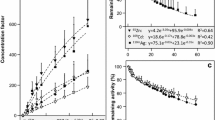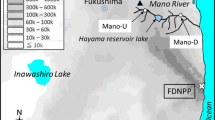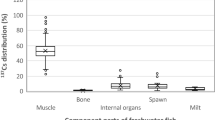Abstract
Japanese dace Tribolodon hakonensis rearing experiments were conducted to estimate parameters related to 137Cs uptake and excretion processes. Fish (initial mean total length 256 mm, 136 g) were reared at 20 °C for 182 days using the same daily ingestion rate (1% of body weight for 6 days per week) with three feeding regimens: feeding contaminated pellets (80.7 Bq/kg-dry of 137Cs) throughout the experiments (137Cs uptake group), feeding contaminated and non-contaminated pellets respectively for days 0–40 and days 42–180 (137Cs uptake–excretion group), and feeding non-contaminated pellets throughout the experiments (control group). Samples were taken periodically. The 137Cs concentrations in muscle tissues (MU) and whole bodies (WB) were measured using Ge detectors. The 137Cs concentrations in fish that had grown to 240 g by day 182 reached 45.5 Bq/kg-wet in MU and 37.0 Bq/kg-wet in WB in the 137Cs uptake group. A one-compartment model incorporating the growth coefficient estimated that the biological half-lives of 137Cs in MU and WB excluding the growth dilution effect (216 days and 233 days, respectively) were longer than the apparent biological half-lives (100 days and 104 days) observed in the 137Cs uptake–excretion group. The developed method can contribute to promoting precise prediction of radiocesium contamination of fish affected by the Fukushima fallout.




Similar content being viewed by others
References
Aoyama M, Tsumune D, Inomata Y, Tateda Y (2020) Mass balance and latest fluxes of radiocesium derived from the Fukushima accident in the western North Pacific Ocean and coastal regions of Japan. J Environ Radioact 217:106206
Fausch KD (1984) Profitable stream positions for salmonids: relating specific growth rate to net energy gain. Can J Zool 62:441–451
Forseth T, Ugedal O, Næsje TF, Jonsson B (1998) Radiocaesium elimination in fish: variation among and within species. J Appl Ecol 35:847–856
Häsänen E, Kolehmainen S, Miettinen JK (1968) Biological half-times of 137Cs and 22Na in different fish species and their temperature dependence. In: Proceeding of the first international congress of radiation protection. Pergamon Press, London, pp 401–406
Hayashi S (2016) Migration and accumulation of radioactive cesium in the upstream region of river watersheds affected by the Fukushima Daiichi Nuclear Power Plant accident: a review. Global Environ Res 20:45–52
Hewett CJ, Jefferies DF (1976) The accumulation of radioactive caesium from water by the brown trout (Salmo trutta) and its comparison with plaice and rays. J Fish Biol 9:479–489
Hewett CJ, Jefferies DF (1978) The accumulation of radioactive caesium from food by the plaice (Pleuronectes platessa) and the brown trout (Salmo trutta). J Fish Biol 13:143–153
Ishii Y, Matsuzaki SS, Hayashi S (2020) Different factors determine 137Cs concentration factors of freshwater fish and aquatic organisms in lake and river ecosystems. J Environ Radioact 213:106012
Ishikawa Y, Suzuki Y, Kasamatsu F, Nagaya Y, Shinoda Y, Nakamura R, Nakahara M (2003) Effects of salinity on bioaccumulation of orally administered 137Cs in juvenile Japanese sea bass, Lateolabrax japonicus—an experimental study through a single oral dose with RI tracer. Rep Mar Ecol Res Inst 5:27–34 (in Japanese with English abstract)
Ishizaki D, Otake T, Sato T, Yodo T, Yoshioka M, Kashiwagi M (2009) Use of otolith microchemistry to estimate the migratory history of Japanese dace Tribolodon hakonensis in the Kamo River, Mie Prefecture. Nippon Suisan Gakkaishi 75:419–424 (in Japanese with English abstract)
Jefferies DF, Hewett CJ (1971) The accumulation and excretion of radioactive caesium by the plaice (Pleuronectes platessa) and the thornback ray (Raja clavata). J Mar Biol Assoc UK 51:411–422
Kaneko T, Hasegawa S, Uchida K, Ogasawara T, Oyagi A, Hirano T (1999) Acid tolerance of Japanese dace (a cyprinid teleost) in Lake Osorezan, a remarkable acid lake. Zool Sci 16:871–877
Kaneko T (2015) Osmoregulation and excretion of cesium in fish. Bull Soc Sea Water Sci Jpn 69:238–243 (in Japanese)
Katano O (2007) Effects of experimental duration and density of Japanese dace Tribolodon hakonensis on the strength of trophic cascades on benthic algae. Oecologia 154:195–205
Katano O, Nakamura T, Abe SI, Baba Y (2010) Population density, growth and migration via the sea to different streams of Japanese dace Tribolodon hakonensis in lower reaches of small streams. Ichthyol Res 57:1–9
Kevern NR (1966) Feeding rate of carp estimated using a radioisotopic method. Trans Am Fish Soc 95:363–371
Kolehmainen SE (1972) The balances of 137Cs, stable cesium and potassium of bluegill (Lepomis macrochirus RAF.) and other fish in White Oak Lake. Health Phys 23:301–315
Luoma SN, Rainbow PS (2005) Why is metal bioaccumulation so variable? Biodynamics as a unifying concept. Environ Sci Technol 39:1921–1931
Malek MA, Nakahara M, Nakamura R (2004) Uptake, retention and organ/tissue distribution of 137Cs by Japanese catfish (Silurus asotus Linnaeus). J Environ Radioact 77:191–204
Mathews T, Fisher NS, Jeffree RA, Teyssié JL (2008) Assimilation and retention of metals in teleost and elasmobranch fishes following dietary exposure. Mar Ecol Prog Ser 360:1–12
Mathieu A, Kajino M, Korsakissok I, Périllat R, Quélo D, Quérel A, Saunier O, Sekiyama TT, Igarashi Y, Didier D (2018) Fukushima Daiichi-derived radionuclides in the atmosphere, transport and deposition in Japan: a review. Appl Geochem 91:122–139
Matsuda K, Takagi K, Tomiya A, Enomoto M, Tsuboi J, Kaeriyama H, Ambe D, Fujimoto K, Ono T, Uchida K, Morita T, Yamamoto S (2015) Comparison of radioactive cesium contamination of lake water, bottom sediment, plankton, and freshwater fish among lakes of Fukushima Prefecture, Japan after the Fukushima fallout. Fish Sci 81:737–747
Metian M, Pouil S, Fowler SW (2019) Radiocesium accumulation in aquatic organisms: a global synthesis from an experimentalist’s perspective. J Environ Radioact 198:147–158
Morgan IJ, Tytler P, Bell MV (1993) The accumulation of 137–caesium from fresh water by alevins and fry of Atlantic salmon and brown trout. J Fish Biol 43:877–888
Morishita D, Wada T, Noda T, Tomiya A, Enomoto M, Sato T, Suzuki S, Kawata G (2019) Spatial and seasonal variations of radiocesium concentrations in an algae-grazing annual fish, ayu Plecoglossus altivelis collected from Fukushima Prefecture in 2014. Fish Sci 85:561–569
Pan K, Wang WX (2016) Radiocesium uptake, trophic transfer, and exposure in three estuarine fish with contrasting feeding habits. Chemosphere 163:499–507
Peters EL, Newman MC (1999) 137Cs elimination by chronically contaminated largemouth bass (Micropterus salmoides). Health Phys 76:260–268
Pouil S, Teyssié JL, Fowler SW, Metian M, Warnau M (2018a) Interspecific comparison of radiocesium trophic transfer in two tropical fish species. J Environ Radioact 189:261–265
Pouil S, Oberhänsli F, Swarzenski PW, Bustamante P, Metian M (2018b) The role of salinity in the trophic transfer of 137Cs in euryhaline fish. J Environ Radioact 189:255–260
Reinfelder JR, Fisher NS, Luoma SN, Nichols JW, Wang WX (1998) Trace element trophic transfer in aquatic organisms: a critique of the kinetic model approach. Sci Total Environ 219:117–135
Rowan DJ, Rasmussen JB (1994) Bioaccumulation of radiocesium by fish: the influence of physicochemical factors and trophic structure. Can J Fish Aquat Sci 51:2388–2410
Rowan DJ, Chant LA, Rasmussen JB (1998) The fate of radiocesium in freshwater communities—why is biomagnification variable both within and between species? J Environ Radioact 40:15–36
Saito K, Tanihata I, Fujiwara M, Saito T, Shimoura S, Otsuka T, Onda Y, Hoshi M, Ikeuchi Y, Takahashi F, Kinouchi N, Saegusa J, Seki A, Takemiya H, Shibata T (2015) Detailed deposition density maps constructed by large-scale soil sampling for gamma-ray emitting radioactive nuclides from the Fukushima Dai-ichi Nuclear Power Plant accident. J Environ Radioact 139:308–319
Sakai H (1995) Life-histories and genetic divergence in three species of Tribolodon (Cyprinidae). Mem Fac Fish Hokkaido Univ 42:1–98
Satoh K, Maita M, Wakamatsu A, Matsuda S (2003) Growth and feed efficiency of adult yellowtail fed extruded pellet diets with two lipid levels and raw-fish diets. Suisanzoshoku 51:343–348 (in Japanese with English abstract)
Sohtome T, Wada T, Mizuno T, Nemoto Y, Igarashi S, Nishimune A, Aono T, Ito Y, Kanda J, Ishimaru T (2014) Radiological impact of TEPCO's Fukushima Dai-ichi Nuclear Power Plant accident on invertebrates in the coastal benthic food web. J Environ Radioact 138:106–115
Srivastava A, Reddy SJ, Kelber O, Urich K, Denschlag HO (1994) Uptake and release kinetics of 134Cs by zebra fish (Brachydanio rerio) in controlled aquatic environment. J Radioanal Nucl Chem 182:63–69
Steinhauser G, Brandl A, Johnson TE (2014) Comparison of the Chernobyl and Fukushima nuclear accidents: a review of the environmental impacts. Sci Total Environ 470–471:800–817
Suzuki K, Onozeki Y, Tanaka H, Matsuoka E, Kuge T, Tsunoda K, Aizawa S, Mori M, Nohara S, Minai Y, Okada Y, Nagao S (2016) Estimation of the biological half-life of radioactive cesium in wakasagi Hypomesus nipponensis. Nippon Suisan Gakkaishi 82:774–776 (in Japanese)
Suzuki K, Watanabe S, Yuasa Y, Yamashita Y, Arai H, Tanaka H, Kuge T, Mori M, Tsunoda K, Nohara S, Iwasaki Y, Minai Y, Okada Y, Nagao S (2018) Radiocesium dynamics in the aquatic ecosystem of Lake Onuma on Mt. Akagi following the Fukushima Dai-ichi Nuclear Power Plant accident. Sci Total Environ 622–623:1153–1164
Twining JR, Ferris JM, Markish SJ (1996) Bioaccumulation of 137Cs and 85Sr by an Australian sub-tropical freshwater teleost (Bidyanus bidyanus). Sci Total Environ 192:245–257
Ugedal O, Jonsson B, Njåstad O, Næumann R (1992) Effects of temperature and body size on radiocaesium retention in brown trout, Salmo trutta. Fresh Biol 28:165–171
Wada T, Nemoto Y, Shimamura S, Fujita T, Mizuno T, Sohtome T, Kamiyama K, Morita T, Igarashi S (2013) Effects of the nuclear disaster on marine products in Fukushima. J Environ Radioact 124:246–254
Wada T, Tomiya A, Enomoto M, Sato T, Morishita D, Izumi S, Niizeki K, Suzuki S, Morita T, Kawata G (2016a) Radiological impact of the nuclear power plant accident on freshwater fish in Fukushima: an overview of monitoring results. J Environ Radioact 151:144–155
Wada T, Fujita T, Nemoto Y, Shimamura S, Mizuno T, Sohtome T, Kamiyama K, Narita K, Watanabe M, Hatta N, Ogata Y, Morita T, Igarashi S (2016b) Effects of the nuclear disaster on marine products in Fukushima: an update after five years. J Environ Radioact 164:312–324
Wada T, Sato T, Morishita D, Takasaki K, Izumi S, Suzuki S, Kawata G (2018) Radioactive contamination of freshwater fish by monitoring inspections of Fukushima Prefecture. Kaiyo Monthly 50:8–13 (in Japanese)
Wada T, Konoplev A, Wakiyama Y, Watanabe K, Furuta Y, Morishita D, Kawata G, Nanba K (2019) Strong contrast of cesium radioactivity between marine and freshwater fish in Fukushima. J Environ Radioact 204:132–142
Wakiyama Y, Konoplev A, Wada T, Takase T, Byrnes I, Carradine M, Nanba K (2017) Behavior of 137Cs in ponds in the vicinity of the Fukushima Dai-ichi nuclear power plant. J Environ Radioact 178–179:367–376
Yasutaka T, Tsuji H, Kondo Y, Suzuki Y (2013) Development of rapid monitoring for dissolved radioactive cesium with a cartridge type of Prussian blue-impregnated nonwoven fabric. Bunseki Kagaku 62:499–506 (in Japanese with English abstract)
Yasutaka T, Tsuji H, Kondo Y, Suzuki Y, Takahashi A, Kawamoto T (2015) Rapid quantification of radiocesium dissolved in water by using nonwoven fabric cartridge filters impregnated with potassium zinc ferrocyanide. J Nucl Sci Tech 52:792–800
Acknowledgements
We are grateful to S. Suzuki and G. Kawata and other staff of the Fukushima Prefectural Inland Water Fisheries Experiment Station for their support of the rearing experiments. Portions of this study were supported by a Grant-in-Aid for Young Scientists (A) (16H06199) and a Grant-in-Aid for Scientific Research (B) (20H03056) from the Ministry of Education, Culture, Sports, Science and Technology, Japan.
Author information
Authors and Affiliations
Corresponding author
Additional information
Publisher's Note
Springer Nature remains neutral with regard to jurisdictional claims in published maps and institutional affiliations.
Electronic supplementary material
Below is the link to the electronic supplementary material.
Rights and permissions
About this article
Cite this article
Niizeki, K., Wada, T., Nanba, K. et al. Estimating biological half-lives of 137Cs in a cyprinid fish Tribolodon hakonensis by a one-compartment model considering growth dilution effect. Fish Sci 86, 861–871 (2020). https://doi.org/10.1007/s12562-020-01452-y
Received:
Accepted:
Published:
Issue Date:
DOI: https://doi.org/10.1007/s12562-020-01452-y




